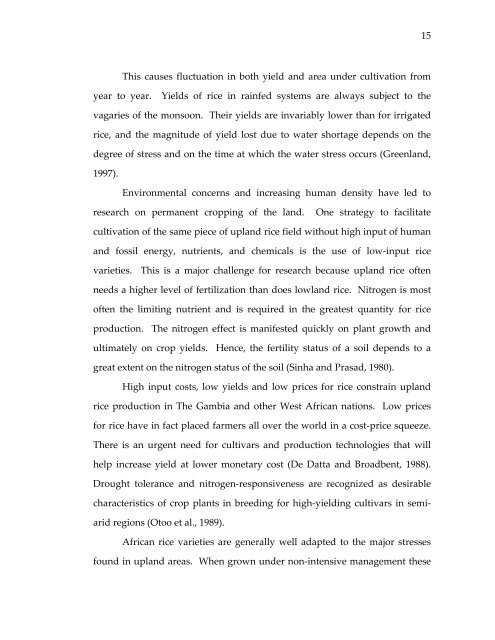Management of rice production systems to increase productivity
Management of rice production systems to increase productivity
Management of rice production systems to increase productivity
Create successful ePaper yourself
Turn your PDF publications into a flip-book with our unique Google optimized e-Paper software.
This causes fluctuation in both yield and area under cultivation from<br />
year <strong>to</strong> year. Yields <strong>of</strong> <strong>rice</strong> in rainfed <strong>systems</strong> are always subject <strong>to</strong> the<br />
vagaries <strong>of</strong> the monsoon. Their yields are invariably lower than for irrigated<br />
<strong>rice</strong>, and the magnitude <strong>of</strong> yield lost due <strong>to</strong> water shortage depends on the<br />
degree <strong>of</strong> stress and on the time at which the water stress occurs (Greenland,<br />
1997).<br />
Environmental concerns and increasing human density have led <strong>to</strong><br />
research on permanent cropping <strong>of</strong> the land. One strategy <strong>to</strong> facilitate<br />
cultivation <strong>of</strong> the same piece <strong>of</strong> upland <strong>rice</strong> field without high input <strong>of</strong> human<br />
and fossil energy, nutrients, and chemicals is the use <strong>of</strong> low‐input <strong>rice</strong><br />
varieties. This is a major challenge for research because upland <strong>rice</strong> <strong>of</strong>ten<br />
needs a higher level <strong>of</strong> fertilization than does lowland <strong>rice</strong>. Nitrogen is most<br />
<strong>of</strong>ten the limiting nutrient and is required in the greatest quantity for <strong>rice</strong><br />
<strong>production</strong>. The nitrogen effect is manifested quickly on plant growth and<br />
ultimately on crop yields. Hence, the fertility status <strong>of</strong> a soil depends <strong>to</strong> a<br />
great extent on the nitrogen status <strong>of</strong> the soil (Sinha and Prasad, 1980).<br />
High input costs, low yields and low p<strong>rice</strong>s for <strong>rice</strong> constrain upland<br />
<strong>rice</strong> <strong>production</strong> in The Gambia and other West African nations. Low p<strong>rice</strong>s<br />
for <strong>rice</strong> have in fact placed farmers all over the world in a cost‐p<strong>rice</strong> squeeze.<br />
There is an urgent need for cultivars and <strong>production</strong> technologies that will<br />
help <strong>increase</strong> yield at lower monetary cost (De Datta and Broadbent, 1988).<br />
Drought <strong>to</strong>lerance and nitrogen‐responsiveness are recognized as desirable<br />
characteristics <strong>of</strong> crop plants in breeding for high‐yielding cultivars in semi‐<br />
arid regions (O<strong>to</strong>o et al., 1989).<br />
African <strong>rice</strong> varieties are generally well adapted <strong>to</strong> the major stresses<br />
found in upland areas. When grown under non‐intensive management these<br />
15
















